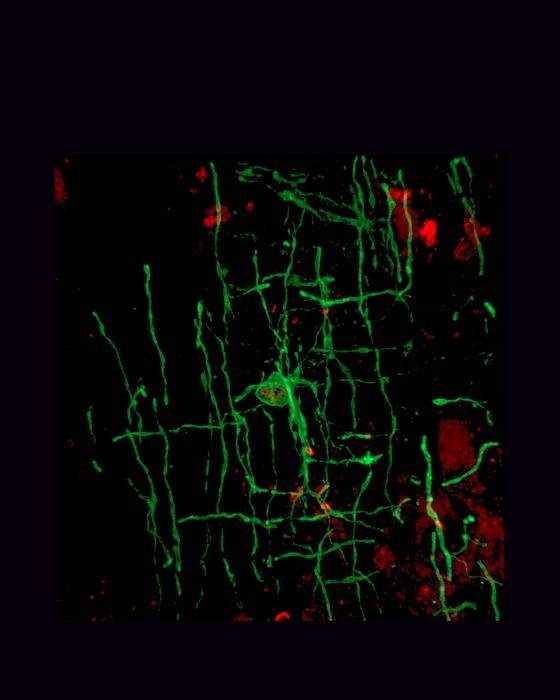According to a study published in the journal Cell, ancient viruses may have contributed to the development of myelin and, consequently, the large, complex brains.
 A Myelinating Oligodendrocyte (Green). Image Credit: Peggy Assinck, Altos Labs-Cambridge Institute of Science
A Myelinating Oligodendrocyte (Green). Image Credit: Peggy Assinck, Altos Labs-Cambridge Institute of Science
The researchers discovered that the synthesis of myelin in fish, amphibians, and mammals depends on a genetic element called a “retrotransposon,” which is derived from a retrovirus. The gene sequence, which they named “RetroMyelin,” most likely originated from an ancient viral infection. Studies comparing RetroMyelin in fish, amphibians, and mammals indicate that genome-invasion events and retroviral infection happened independently in each of these animal groups.
Retroviruses were required for vertebrate evolution to take off. If we didn’t have retroviruses sticking their sequences into the vertebrate genome, then myelination wouldn’t have happened, and without myelination, the whole diversity of vertebrates as we know it would never have happened.”
Robin Franklin, Senior Author and Neuroscientist, Cambridge Institute of Science
A complex, fatty tissue called myelin surrounds the axons of vertebrate nerves. It permits fast impulse conduction without requiring an increase in axonal diameter, allowing nerves to be arranged in closer proximity. Additionally, it supports nerve metabolism, allowing nerves to grow longer.
Myelin's significance in vertebrate evolution has long been acknowledged, but up until now, it was unknown what molecular mechanisms led to its appearance. Myelin first appeared in the tree of life around the same time as jaws.
Examining the gene networks used by oligodendrocytes - the cells in the central nervous system that produce myelin - the researchers discovered RetroMyelin’s function in myelin production. In particular, the group was examining - something that has not been done before in the context of myelin biology - the function of noncoding regions, such as retrotransposons, in these gene networks.
Retrotransposons compose about 40% of our genomes, but nothing is known about how they might have helped animals acquire specific characteristics during evolution. Our motivation was to know how these molecules are helping evolutionary processes, specifically in the context of myelination.”
Tanay Ghosh, First Author and Computational Biologist, Cambridge Institute of Science
One of the essential elements of myelin, myelin basic protein, is expressed differently in rodents depending on the RNA transcript of RetroMyelin, according to the research. The ability of oligodendrocytes and oligodendrocyte progenitor cells - the stem cells from which oligodendrocytes are derived - to produce myelin basic protein was lost when they experimentally inhibited RetroMyelin.
The team looked for similar sequences in the genomes of jawed vertebrates, jawless vertebrates, and a few invertebrate species to see if RetroMyelin was present in other vertebrate species. They found similar sequences in fish, amphibians, birds, and reptiles, but not in any other jawed vertebrates, including invertebrates or jawless vertebrates.
There’s been an evolutionary drive to make impulse conduction of our axons quicker because having quicker impulse conduction means you can catch things or flee from things more rapidly.”
Robin Franklin, Senior Author and Neuroscientist, Cambridge Institute of Science
Subsequently, the researchers sought to determine if distinct retroviral invasions occurred in the various branches or if RetroMyelin was incorporated into the ancestor of all jawed vertebrates at a single time.
They created a phylogenetic tree using 22 species of jawed vertebrates and compared their RetroMyelin sequences to provide answers to these questions. RetroMyelin sequences were found to be more similar within species than between them, indicating that convergent evolution may have resulted in the acquisition of RetroMyelin more than once.
The group also demonstrated the functional role that RetroMyelin plays in fish and amphibian myelination. The developing fish and tadpoles produced noticeably less myelin than usual when the RetroMyelin gene sequence in the fertilized eggs of zebrafish and frogs was experimentally disrupted.
The study highlights the importance of non-coding regions of the genome for physiology and evolution, the researchers say.
Ghosh concludes, “Our findings open up a new avenue of research to explore how retroviruses are more generally involved in directing evolution.”
Source:
Journal reference:
Ghosh, T., et.al. (2024) A retroviral link to vertebrate myelination through retrotransposon-RNA-mediated control of myelin gene expression. Cell. doi.org/10.1016/j.cell.2024.01.011